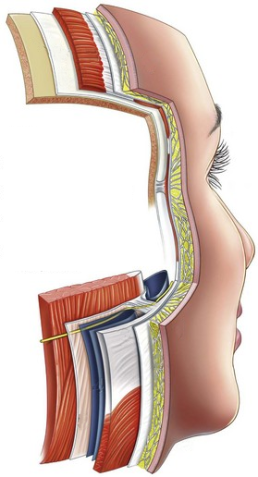A facelift is a cosmetic surgical procedure that rejuvenates the appearance of the face and neck. Depending on the objectives of the patient, the procedure can affect several parts of the facial anatomy. The figure shows four separate areas, and the patient and surgeon decide together which zone or zones should be treated to achieve the desired result. The areas affected can be the lower face, the mid face, the forehead and brow, and the eyelids.
The objective of a facelift procedure is to tighten saggy and lax soft tissues of the face and neck to produce a crisper jawline as well as tighter, smoother skin. The operation repositions various tissue layers of the face and neck, sutures it into place, and excises excess skin. Incisions and sutures are made so that any resulting scars are hidden, as much as possible, behind the ears, above the hairline of the scalp, and in the natural creases of the face.
There are several approaches to performing facelifts, and the optimal method is a balance between costs, recovery time, and patient expectations. Factors that must be considered include age, gender, degree of skin laxity, skin thickness, as well as external factors related to lifestyle.
Surgical methods for facelifts
As mentioned, the type of surgical lift will balance several trade-offs, and will depend on the patient’s objectives as well as the observed degree of laxity in the neck and face. The procedure will depend on the tissue planes to be adjusted, the type of incisions used, and the surgical technology employed. These choices will determine the longevity of the results, and will affect recovery times following the operation. The less invasive the technique is, the speedier the recovery, however it may also be less dramatic and enduring.


Tissue planes
The degree of tightening and smoothing of the skin that can be achieved by a facelift will depend largely on the tissue plane targeted by your surgeon. As shown in the illustration below, the face consists of a series of tissue layers, each with a different function. The outermost group of layers is the skin and subcutaneous fat, and beneath these is a group of muscle and connective tissue. Separating the two groups is a thin layer of tendon like tissue called the SMAS.
facial tissue planes
Facial Tissue Planes
A facelift either tightens the layers below the SMAS or above it. Typically facelifts above the SMAS (for example, mini facelifts) are less invasive, using smaller incisions, and facelifts implemented below the SMAS require broader ones.
For facelifts below the SMAS (deep tissue plane lift), the surgeon tightens the muscle layer. However, to accomplish this he or she needs to separate it from the SMAS. This requires good visual access, and thus a broader incision. A sub-SMAS facelift produces significant surgical trauma, but also can deliver a more substantive and longer lasting result.
Facelifts performed above the SMAS (shallow tissue plane lifts) are primarily focused on tightening the soft tissues of skin and subcutaneous fat. It produces a more a more natural result, and can be performed without direct visual access to the tissue layers. For these reasons, these types of facelifts can be performed with much smaller incisions, and provoke significantly less surgical trauma.
Whether the patient and surgeon opt for a deeper plane facelift or a shallower one will depend on a variety of factors. Those performed below the SMAS will require significantly longer recovery periods, are most expensive, and might not provide a better result than those above the SMAS. These trade-offs need to be discussed between the patient and their surgeon.
Types of incisions
There are several ways of accessing the tissue planes. The types of incisions made are classified as short scars (called S-scars or MACS), long scars, extended scars, and keyhole scars.
A shorter scar is not necessarily better. Short incisions can sometimes result in puckering or a visible reorientation of skin. This only happens, however, if too much tightening is attempted for a shallow tissue plane facelift. If the surgeon properly assesses the needs of the patient and remains within reasonable bounds puckering is unlikely to happen.
Regardless of the scar length, your surgeon will plan their incisions so that natural creases in the skin act to hide them. Moreover, they will close and suture the incision in way that minimizes the appearance of the resulting scar. In some cases, post-operative treatments will be considered to achieve even greater visible reductions in scarring.

